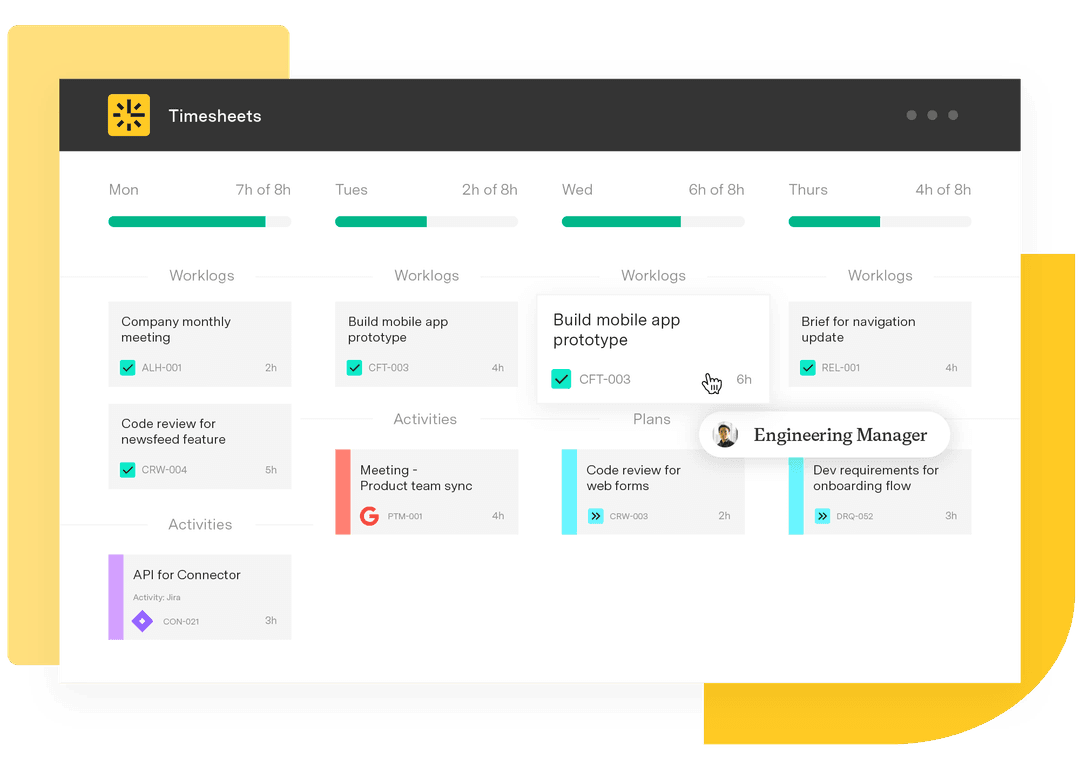The ladder of inference: How thoughts shape decisions
Tempo Team
Picture this: You walk away from a presentation feeling uncertain about your performance. You spend the rest of the day replaying it in your mind and wondering if you should have done things differently. Soon, your head is swimming with anxious thoughts.
“They didn’t like my idea.”
“Maybe they think I’m not pulling my weight.”
“I should probably fix that slide deck.”
These mental leaps happen fast – often before you even realize it. It’s called the ladder of inference, a concept that explains how people turn a simple observation into a belief that influences their actions. It’s how the brain makes sense of the world, but it can also lead to misunderstandings and rash decisions.
Understanding each run of the ladder of inference helps you think clearly and communicate effectively, especially when the stakes are high.
What is the ladder of inference?
The ladder of inference model – developed by business theorist Chris Argyris – describes the mental steps people climb as they turn perceptions into beliefs and decisions. Argyris’s theory explains why people sometimes move quickly from observing facts to taking action, often without realizing it.
Here’s how it works:
People observe data or experiences.
They select the data that catches their attention, ignoring the rest.
They add meaning based on past experiences and existing beliefs.
That meaning is used to make assumptions.
Conclusions are drawn based on those assumptions.
Those conclusions inform people’s beliefs.
Finally, people take action based on those beliefs.
This process often occurs unconsciously. Personal biases and past experiences influence the data people deem important and how fast they climb the rungs of this ladder. If they climb too quickly, they may jump to conclusions or make unwise decisions based on incomplete or biased information. The ladder of inference example at the start of this guide shows how these beliefs can quickly spiral out of control.
Benefits of understanding the ladder of inference
Once you understand the ladder of inferences and the meaning of each ladder option, you’re better equipped to pause and examine your thought process before making decisions. This self-awareness encourages you to ask better questions and respond with logical actions.
The ladder of inferences provides a framework that can dramatically improve your decision-making, especially if you’re following a project manager career path or building stronger product portfolio management strategies. Here’s how that benefits you and your team:
Sharpens decisions
People don’t act on facts; they act on their interpretation of facts. You make smarter, more grounded choices by slowing down and examining the data you focus on (and the information you ignore).
Boosts communication
Misunderstandings often start with hidden assumptions. Remembering the ladder of inference helps you pause before reacting so you can investigate those assumptions. This habit leads to clearer conversations and more thoughtful responses.
Strengthens collaboration
When team members know how to slow their climb up the ladder, they’re better at working through tension and solving problems together. There’s more curiosity and less blame – the ideal dynamic for creative, high-performing teams.
Increases self-awareness
You build mental muscle every time you catch yourself before jumping to conclusions based on simple observations. You get better at recognizing your biases and mental models, which gives you more control over your thought processes – and fewer regrets after meetings or decisions.
The 7 steps of the ladder of inference
Once you understand the ladder of inference, you’ll notice how quickly your brain moves from observing something to deciding what it means – and even what to do about it.
Here’s how we move up each rung of the ladder, often in a matter of seconds.
1. Observing data and experiences
This is the bottom of the ladder. It’s everything you can see, hear, or otherwise observe – raw facts and objective data. For example, a teammate folds their arms and looks away while you’re talking. That’s an observable fact.
2. Selecting data
The brain naturally filters available observations and selects what it pays attention to. The things people notice are shaped by past experiences, mental habits, and workplace dynamics. In the previous example, you might zero in on your colleague’s folded arms while ignoring that they had a stressful morning.
3. Adding meaning
Now, the brain starts to interpret. People assign meaning to their selected data based on their culture, values, or emotional state. Maybe you decide the teammate is annoyed with you. The raw data hasn’t changed, but your thought process has added a new layer.
4. Making assumptions
Based on the assigned meaning, people start to assume further information. However, it’s only a guess — one that can spiral if left unchecked. Perhaps you assume the teammate is upset because of something you said.
5. Drawing conclusions
People take their assumptions and turn them into full-fledged conclusions. This step feels like clarity, but it’s confirmation bias in action, making the story in your head feel more real than the facts. You may conclude that your colleague doesn’t respect your input.
6. Adopting beliefs
Over time, people construct beliefs based on their conclusions. These beliefs can affect the data they focus on in future observations, further reinforcing their biases. If you’re always expecting your teammate to dismiss your contributions, you could start to believe that they’re trying to sabotage you.
7. Taking action
Finally, people act based on their beliefs. And if the belief was flawed, the action may be, too. That’s where misunderstandings and poor decision-making start. Maybe you stop asking your teammate for feedback, avoid collaborating with them, or escalate the issue.
Factors influencing the ladder of inference
Everyone climbs the ladder of inference, but the speed of that climb and the observations you start with are shaped by more than just the situation at hand. Internal and external factors influence how you interpret data, draw conclusions, and ultimately take action. Some of these drivers operate quietly in the background, pushing you up the ladder faster than you realize.
Here are several factors that can affect your thought process and influence project success:
Cognitive bias
Biases are mental shortcuts that help people make sense of the world, but they often lead to hasty conclusions.
For instance, confirmation bias causes people to focus on data that supports their current beliefs and filter out anything that challenges them. If you believe a team member is unreliable, and they miss a deadline, you might ignore that they’re overwhelmed with urgent tasks and instead assume laziness.
Organizational culture
Your environment influences how you interpret data and how comfortable you feel questioning your assumptions.
In a culture that prizes speed, people might feel discouraged from seeking clarification, leading them to act based on limited data. Conversely, a psychologically safe culture encourages curiosity and open dialogue, making people more likely to pause before climbing the ladder so they can ask questions and avoid unnecessary conflict.
Past experiences
Past experiences shape how people view the present, especially when they’re under pressure.
For example, if you’re used to being criticized in meetings, you may assume that silence from your project manager signals disapproval, even if they’re just processing your contributions. However, these conclusions are drawn based on past experiences, not currently observable data. They can trigger defensive behaviors that create unnecessary tension.
Communication breakdowns
People instinctively try to fill in the blanks when communication is vague or missing context, but the story they construct is rarely neutral. Mental models, stress levels, and preexisting beliefs all come into play. Poor communication leads to limited data, and limited data leads to flawed conclusions.
Enhancing strategic thinking and communication with Tempo
It’s easy to jump to conclusions without noticing. Tempo helps teams break that cycle by providing real, precise data.
Custom Charts for Jira delivers intuitive visualizations of project status, eliminating confusion and guesswork. Timesheets makes tracking work transparent and straightforward, so decisions are informed by facts instead of assumptions.
Tempo aligns your team behind a single source of truth. Communication flows better, and smarter decisions follow. Try Tempo to discover how data-driven clarity can transform your team’s outlook.













































